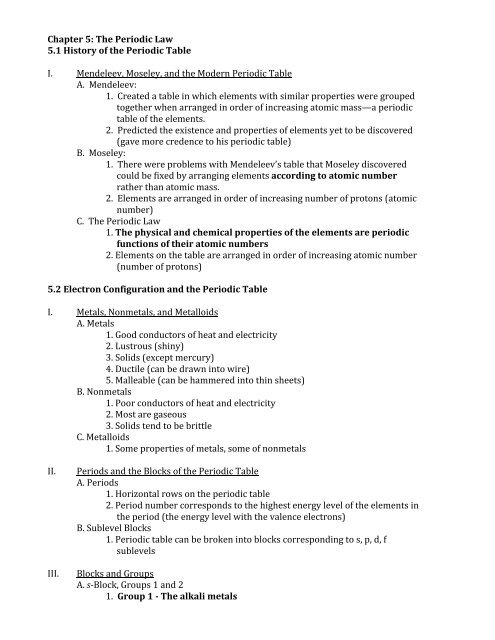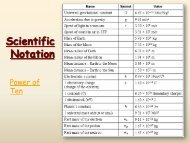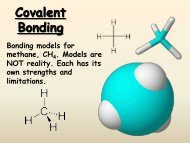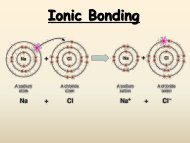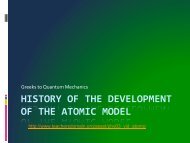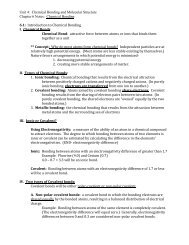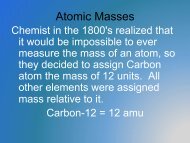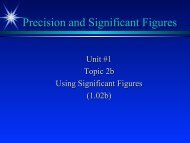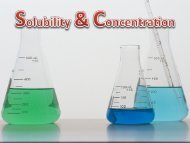Chapter 5: The Periodic Law 5.1 History of the Periodic Table I. M
Chapter 5: The Periodic Law 5.1 History of the Periodic Table I. M
Chapter 5: The Periodic Law 5.1 History of the Periodic Table I. M
- No tags were found...
Create successful ePaper yourself
Turn your PDF publications into a flip-book with our unique Google optimized e-Paper software.
<strong>Chapter</strong> 5: <strong>The</strong> <strong>Periodic</strong> <strong>Law</strong> <strong>5.1</strong> <strong>History</strong> <strong>of</strong> <strong>the</strong> <strong>Periodic</strong> <strong>Table</strong> I. Mendeleev, Moseley, and <strong>the</strong> Modern <strong>Periodic</strong> <strong>Table</strong> A. Mendeleev: 1. Created a table in which elements with similar properties were grouped toge<strong>the</strong>r when arranged in order <strong>of</strong> increasing atomic mass—a periodic table <strong>of</strong> <strong>the</strong> elements. 2. Predicted <strong>the</strong> existence and properties <strong>of</strong> elements yet to be discovered (gave more credence to his periodic table) B. Moseley: 1. <strong>The</strong>re were problems with Mendeleev’s table that Moseley discovered could be fixed by arranging elements according to atomic number ra<strong>the</strong>r than atomic mass. 2. Elements are arranged in order <strong>of</strong> increasing number <strong>of</strong> protons (atomic number) C. <strong>The</strong> <strong>Periodic</strong> <strong>Law</strong> 1. <strong>The</strong> physical and chemical properties <strong>of</strong> <strong>the</strong> elements are periodic functions <strong>of</strong> <strong>the</strong>ir atomic numbers 2. Elements on <strong>the</strong> table are arranged in order <strong>of</strong> increasing atomic number (number <strong>of</strong> protons) 5.2 Electron Configuration and <strong>the</strong> <strong>Periodic</strong> <strong>Table</strong> I. Metals, Nonmetals, and Metalloids A. Metals 1. Good conductors <strong>of</strong> heat and electricity 2. Lustrous (shiny) 3. Solids (except mercury) 4. Ductile (can be drawn into wire) 5. Malleable (can be hammered into thin sheets) B. Nonmetals 1. Poor conductors <strong>of</strong> heat and electricity 2. Most are gaseous 3. Solids tend to be brittle C. Metalloids 1. Some properties <strong>of</strong> metals, some <strong>of</strong> nonmetals II. III. Periods and <strong>the</strong> Blocks <strong>of</strong> <strong>the</strong> <strong>Periodic</strong> <strong>Table</strong> A. Periods 1. Horizontal rows on <strong>the</strong> periodic table 2. Period number corresponds to <strong>the</strong> highest energy level <strong>of</strong> <strong>the</strong> elements in <strong>the</strong> period (<strong>the</strong> energy level with <strong>the</strong> valence electrons) B. Sublevel Blocks 1. <strong>Periodic</strong> table can be broken into blocks corresponding to s, p, d, f sublevels Blocks and Groups A. s-‐Block, Groups 1 and 2 1. Group 1 -‐ <strong>The</strong> alkali metals
a. One s electron in outer shell b. S<strong>of</strong>t, silvery metals <strong>of</strong> low density and low melting points c. Highly reactive, never found pure in nature 2. Group 2 -‐ <strong>The</strong> alkaline earth metals a. Two s electrons in outer shell b. Denser, harder, stronger, less reactive than Group 1 c. Too reactive to be found pure in nature B. d-‐Block, Groups 3 -‐ 12 1. Metals with typical metallic properties 2. Referred to as "transition" metals 3. Group number = sum <strong>of</strong> outermost s and d electrons C. p-‐Block elements, Groups 13 -‐ 18 1. Properties vary greatly a. Metals (1) s<strong>of</strong>ter and less dense than d-‐block metals (2) harder and more dense than s-‐block metals b. Metalloids (1) Brittle solids with some metallic and some nonmetallic properties (2) Semiconductors c. Nonmetals (1) Halogens (Group 17) are most reactive <strong>of</strong> <strong>the</strong> nonmetals D. f-‐Block, Lanthanides and Actinides (inner transition metals) 1. In <strong>the</strong> periodic table, <strong>the</strong> f-‐block elements are wedged between Groups 3 and 4 in <strong>the</strong> sixth and seventh periods. 2. Lanthanides are shiny metals similar in reactivity to <strong>the</strong> Group 2 metals 3. Actinides a. All are radioactive b. Transuranium: elements after uranium-‐ all man-‐made IV. <strong>Periodic</strong> Facts: 1. 92 naturally occurring elements 2. Elements 93 and above (transurnaium) are all man-‐made 3. Elements 43 and 61 (technetium and promethium) are also syn<strong>the</strong>tic (man-‐made) 4. All elements after #83 (84 polonium and above) are radioactive 5.3 <strong>Periodic</strong> Trends I. Atomic Radii A. Atomic Radius 1. One half <strong>the</strong> distance between nuclei <strong>of</strong> identical atoms that are bonded toge<strong>the</strong>r B. Trends 1. Atomic radius tends to decrease across a period due to increasing positive nuclear charge 2. Atomic radii tend to increase down a group due to increasing number energy levels (outer electrons are far<strong>the</strong>r from <strong>the</strong> nucleus) II. Ionization Energy A. Ion 1. An atom or a group <strong>of</strong> atoms that has a positive or negative charge 2. Positive charge: cation (loss <strong>of</strong> electrons)
3. Negative charge: anion (gain <strong>of</strong> electrons) B. Ionization 1. Any process that results in <strong>the</strong> formation <strong>of</strong> an ion C. Ionization Energy (IE) 1. <strong>The</strong> energy required to remove one electron from a neutral atom <strong>of</strong> an element, measured in kilojoules/mole (kJ/mol) ! + !"!#$% → ! ! + ! ! D. Trends 1. Ionization energy <strong>of</strong> main-‐group elements tends to increase across each period a. Atoms are getting smaller, electrons are closer to <strong>the</strong> nucleus (increased nuclear charge = stronger attraction for electrons in <strong>the</strong> same energy level) 2. Ionization energy <strong>of</strong> main-‐group elements tends to decrease as atomic number increases in a group (down <strong>the</strong> group) a. Atoms are getting larger; electrons are far<strong>the</strong>r from <strong>the</strong> nucleus b. Outer electrons become increasingly more shielded from <strong>the</strong> nucleus by inner electrons = easier to remove 3. Metals have a characteristic low ionization energy 4. Nonmetals have a high ionization energy 5. Noble gases have a very high ionization energy E. Removing Additional Electrons !" + !"#$% !"# → !" ! + ! ! !" ! + !"#$%& !"# → !" !! + ! ! !" !! + !"#$%& !"# → !" !!! + ! _ 1. Ionization energy increases for each successive electron 2. Each electron removed experiences a stronger effective nuclear charge (more positive charges than negative charges) 3. <strong>The</strong> greatest increase in ionization energy comes when trying to remove an electron from a stable, noble gas configuration (complete octet in <strong>the</strong> outer energy level) III. IV. Trends in Ionic Size A. Cations 1. Positive ions 2. Always Smaller than <strong>the</strong> corresponding atom a. Protons outnumber electrons b. Less shielding <strong>of</strong> electrons B. Anions 1. Negative ions 2. Always Larger than <strong>the</strong> corresponding atoms a. Electrons outnumber protons b. Greater electron-‐electron repulsion C. Trends 1. Ion size tends to increase downward within a group 2. Cationic and anionic radii decrease across <strong>the</strong> period Trends in Electronegativity
A. Electronegativity 1. A measure <strong>of</strong> <strong>the</strong> ability <strong>of</strong> an atom in a chemical compound to attract electrons 2. Elements that do not form compounds are not assigned electronegativities B. Trends 1. Nonmetals have characteristically high electronegativity a. Highest in <strong>the</strong> upper right corner (highest = Fluorine 4.0) 2. Metals have characteristically low electronegativity a. Lowest in <strong>the</strong> lower left corner <strong>of</strong> <strong>the</strong> table (Fr and Cs 0.7) 3. Electronegativity tends to increase across a period 4. Electronegativity tends to decrease down a group <strong>of</strong> main-‐group elements V. Valence Electrons A. Electrons in <strong>the</strong> outer energy level (s & p blocks) 1. Electrons available to be lost, gained, or shared in <strong>the</strong> formation <strong>of</strong> chemical compounds 2. Chemical compounds form because electrons are lost, gained, or shared between atoms 3. Electrons that interact are those in <strong>the</strong> highest energy levels (s & p blocks) VI. Sample Problems 1.) Identify <strong>the</strong> group, period, and block in which <strong>the</strong> element that has <strong>the</strong>electron configuration [Xe]6s 2 is located.2.) Write <strong>the</strong> electron configuration for <strong>the</strong> Group 1 element in <strong>the</strong> third period.Is this element likely to be more reactive or less reactive than <strong>the</strong> elementdescribed in (a)?3.) An element has <strong>the</strong> electron configuration [Kr]4d 5 5s 1 . Identify <strong>the</strong> period,block, and group in which this element is located. <strong>The</strong>n, consult <strong>the</strong> periodictable to identify this element and <strong>the</strong> o<strong>the</strong>rs in its group.4.) Without looking at <strong>the</strong> periodic table, write <strong>the</strong> outer electron configuration for<strong>the</strong> Group 14 element in <strong>the</strong> second period. <strong>The</strong>n, name <strong>the</strong> element, andidentify it as a metal, nonmetal, or metalloid.5.) Name <strong>the</strong> block and group in which each <strong>of</strong> <strong>the</strong> following elements is locatedin <strong>the</strong> periodic table. <strong>The</strong>n, use <strong>the</strong> periodic table to name each element.Identify each element as a metal, nonmetal, or metalloid. Finally, describewhe<strong>the</strong>r each element has high reactivity or low reactivity.a. [Xe]4f 14 5d 9 6s 1 c. [Ne]3s 2 3p 6b. [Ne]3s 2 3p 5 d. [Xe]4f 6 6s 26.) Of <strong>the</strong> elements magnesium, Mg, chlorine, Cl, sodium, Na, and phosphorus,P, which has <strong>the</strong> largest atomic radius? Explain your answer in terms <strong>of</strong>trends <strong>of</strong> <strong>the</strong> periodic table.7.) Consider two main-group elements, A and B. Element A has a first ionizationenergy <strong>of</strong> 419 kJ/mol. Element B has a first ionization energy <strong>of</strong> 1000 kJ/mol.
Decide if each element is more likely to be in <strong>the</strong> s block or p block. Whichelement is more likely to form a positive ion?8.) Of <strong>the</strong> elements gallium, Ga, bromine, Br, and calcium, Ca, which has <strong>the</strong>highest electronegativity? Explain your answer in terms <strong>of</strong> periodic trends.Solutions to notes problems above: 1.) <strong>The</strong> element is in Group 2, as indicated by <strong>the</strong> group configuration <strong>of</strong> ns 2 .It is in <strong>the</strong> sixth period, as indicated by <strong>the</strong> highest principal quantum number in itsconfiguration, 6.<strong>The</strong> element is in <strong>the</strong> s block.2,) In a third-period element, <strong>the</strong> highest occupied energy level is <strong>the</strong> third main energylevel, n = 3. <strong>The</strong> 1s, 2s, and 2p sublevels are completely filled.This element has <strong>the</strong> following configuration:1s 2 2s 2 2p 6 3s 1 or [Ne]3s 1Because it is in Group 1, this element is likely to be more reactive than <strong>the</strong> elementdescribed in (a), which is in Group 2.3.) <strong>The</strong> number <strong>of</strong> <strong>the</strong> highest occupied energy level is 5, so <strong>the</strong> element is in <strong>the</strong> fifthperiod.<strong>The</strong>re are five electrons in <strong>the</strong> d sublevel, which means that it is incompletely filled.<strong>The</strong> d sublevel can hold 10 electrons. <strong>The</strong>refore, <strong>the</strong> element is in <strong>the</strong> d block.For d-block elements, <strong>the</strong> number <strong>of</strong> electrons in <strong>the</strong> ns sublevel (1) plus <strong>the</strong> number <strong>of</strong>electrons in <strong>the</strong> (n - 1)d sublevel (5) equals <strong>the</strong> group number, 6.This Group 6 element is molybdenum. <strong>The</strong> o<strong>the</strong>rs in Group 6 are chromium, tungsten,and seaborgium.4.) <strong>The</strong> group number is higher than 12, so <strong>the</strong> element is in <strong>the</strong> p block.<strong>The</strong> total number <strong>of</strong> electrons in <strong>the</strong> highest occupied s and p sublevels is <strong>the</strong>reforeequal to <strong>the</strong> group number minus 10 (14 - 10 = 4).Two electrons are in <strong>the</strong> s sublevel, so two electrons must also be present in <strong>the</strong> 2psublevel.<strong>The</strong> outer electron configuration is 2s 2 2p 2 .<strong>The</strong> element is carbon, C, which is a nonmetal.5.)a. <strong>The</strong> 4f sublevel is filled with 14 electrons. <strong>The</strong> 5d sublevel is partially filled with nineelectrons. <strong>The</strong>refore, this element is in <strong>the</strong> d block. <strong>The</strong> element is <strong>the</strong> transition metalplatinum, Pt, which is in Group 10 and has a low reactivity.b. <strong>The</strong> incompletely filled p sublevel shows that this element is in <strong>the</strong> p block. A total <strong>of</strong>seven electrons are in <strong>the</strong> s and p sublevels, so this element is in Group 17, <strong>the</strong>halogens. <strong>The</strong> element is chlorine, Cl, and is highly reactive.c. This element has a noble-gas configuration and thus is in Group 18 in <strong>the</strong> p block.<strong>The</strong> element is argon, Ar, which is an unreactive nonmetal and a noble gas.d. <strong>The</strong> incomplete 4f sublevel shows that <strong>the</strong> element is in <strong>the</strong> f block and is alanthanide. Group numbers are not assigned to <strong>the</strong> f block. <strong>The</strong> element is samarium,Sm. All <strong>of</strong> <strong>the</strong> lanthanides are reactive metals.
6.) Sodium has <strong>the</strong> largest atomic radius. All <strong>of</strong> <strong>the</strong> elements are in <strong>the</strong> third period. Of<strong>the</strong> four, sodium has <strong>the</strong> lowest atomic number and is <strong>the</strong> first element in <strong>the</strong> period.Atomic radii decrease across a period.7.) Element A has a very low ionization energy, which means that atoms <strong>of</strong> A loseelectrons easily.Element A is most likely to be an s-block metal because ionization energies increaseacross <strong>the</strong> periods.Element B has a very high ionization energy which means that atoms <strong>of</strong> B havedifficulty losing electrons.Element B would most likely lie at <strong>the</strong> end <strong>of</strong> a period in <strong>the</strong> p block.Element A is more likely to form a positive ion because it hasa much lower ionization energy than element B does.8.) All <strong>of</strong> <strong>the</strong>se elements are in <strong>the</strong> fourth period. Bromine has <strong>the</strong> highest atomicnumber and is far<strong>the</strong>st to <strong>the</strong> right in <strong>the</strong> period. Bromine should have <strong>the</strong> highestelectronegativity because electronegativity increases across <strong>the</strong> periods.


